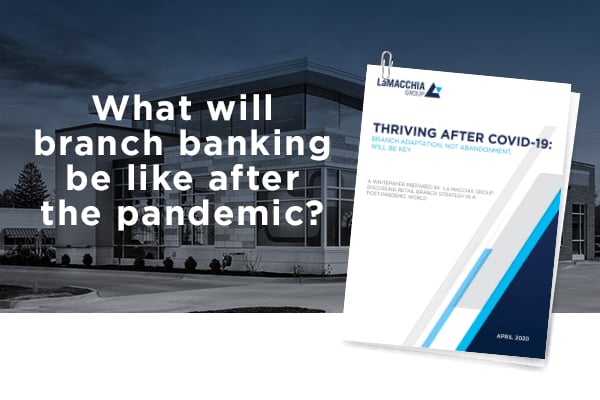As featured inCU Insight, June 4, 2020: Leveraging Technology To Enhance Branch Health And Safety

As many in the financial industry are looking to create or enhance their digital capabilities amidst COVID-19, we’re left to wonder: Will physical branches still be relevant in the aftermath of this pandemic?
This is the question that lies before La Macchia Group, and on a larger scale, an industry that has brokered little change in the last 200 years. As part of our commitment to helping the financial services industry move forward, we conducted research to identify insights that would either inform how branches need to adapt to be successful in a post-pandemic world or determine if success will require a more dramatic shift in service models.
We've summarized the findings in an in-depth whitepaper, with some key highlights below:
The branch is changing. This was true before COVID-19 and many changes will likely accelerate as we consider branch strategies in the post-pandemic world. While we firmly believe the physical branch is core to the business model, and success, of financial institutions, there is no question that HOW they serve their customers will change. Financial leaders will need to look at the functionality, design and purpose of the branch in response to post-pandemic human psychology and emerging safety best practices.
Prior to COVID-19 we were already seeing a trend toward more consultative space within branches, as customers sought out expert guidance on major financial decisions. While some institutions relegated "expertise" as something only desired by or targeted towards high-net-worth individuals, others aligned their support and their spaces to more mainstream needs. Up until now, the demand has been best vocalized by Gen Z. Looking ahead, the need for consultation with financial experts will be amplified as more people seek to adjust or rebuild their finances following COVID-19.
As more consumers are becoming comfortable, or at least capable of conducting routine transactions via mobile apps and banking websites, using ATMs and ITMs when they need to, after experiencing new challenges, financial losses and overall uncertainty, they will crave broader knowledge and control over their finances. Customers look to people as experts and trust banks more when they have physical branches. As such, showcasing the consultative space of the branch, and featuring individual experts as an available and welcoming resource, will build trust and strengthen relationships.
Post COVID-19, many consumers will feel the effects of digital fatigue and will be seeking experiences to escape the digital environment. Simultaneously they will have to confront a newfound concern over the safety of crowds and public spaces. Financial institutions will be required to enable digital connection as a means to communicate physical preparedness; however, if people are uncomfortable with the physical setup of a branch when they see it, they will pursue other channels – or another institution – that makes them feel safe. Modifications that put public health and safety as a top priority will be highly valued by customers and employees alike. In addition to simple branch modifications, more advanced solutions such as automatic doors, thermal scanners at entry points, mass sanitation and HVAC systems are all elements that financial executives can consider both in the lobby as well as in the back office.
When it comes to the consumer journey, the financial services industry has historically been behind the times. For decades, the banking experience has looked and felt the same, and customers were okay with that. But COVID-19 will be a driver of change. Those that remain the same pre-COVID and post-COVID may not survive, and certainly will not thrive. In these uncertain times, one thing is clear: organizations that succeed in the post-pandemic world will be those who recognize and seize the opportunity to look ahead with optimism and choose to adapt.
 |
Tim Klatt | Director of Retail Strategies Tim specializes in developing strategic retail deployments including branch network planning and technology integration. Tim has developed large scale deployment strategies for national and regional retail, restaurant and financial clients and has completed countless market analyses that have led to successful strategic plans for his clients. |
As featured inCU Insight, June 4, 2020: Leveraging Technology To Enhance Branch Health And Safety
So, you’re ready to transform or build a new branch, but before you begin planning for this...
As featured in CU Insight, July 2021:
With nearly four decades in the construction industry, Tom...

MAIN OFFICE
157 North Milwaukee Street
Milwaukee, WI 53202
phone: 414.223.4400
fax: 414.223.4488